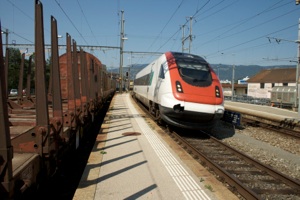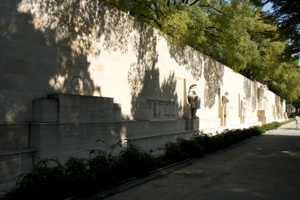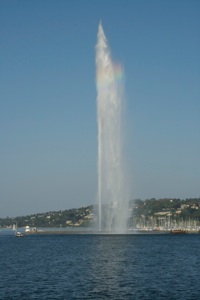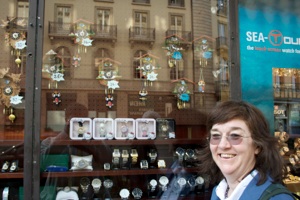We had a think about how we would travel around, planning at least to visit Geneva and Zurich. I checked the price of car hire, but even the cheapest suggested that the Swiss Pass would be a better bet. It’s available only to non-residents and gives the holder unlimited travel on the state railway system, buses, cable cars and 50% discount on the few not covered. So we bought a 15-day one (even though we’ll be back before that, but it’s only slightly more expensive than the 8-day one). So having purchased it we jumped on the first train to come along and it happened to be going to Geneva. Interestingly no one asked to see the ticket AT ALL going there or coming back.
Once we arrived (very smooth interCity train—pity the original Inter City from Paddington to Birmingham Snow Hill no longer runs) we checked the maps and found that it was easy to get to St Peter’s Cathedral, where Calvin preached, the Reformation Museum next door and the park where the Reformation wall is. We could manage it even without a compass (Mr Bean style).
As all readers are bound to know, this is the 500th anniversary of the birth of John Calvin, the Reformer who did so much to promote the Reformation not just in Geneva but throughout Europe. Crossing the bridge to get to the south of the city I had hoped to see the famous Genevan landmark, the Jet d’Eau, a jet of water going up at least 100ft and seen at the start of every episode of the 60s’ programme The Champions, which still appears on ITV4. But it was turned off. Passing near St Peter’s we approached some steps up to Rue Jean Calvin. I wondered why there was a man producing large volumes of smoke from a machine and fanning it forward. Then I saw the cameras, actors and director. You never know, you might see my back in some upcoming blockbuster!
Just beyond we found the park and the Reformation wall. Most pictures I had seen of it just showed the central figures of William Farel, John Calvin, Theodore Beza and John Knox. But it is a great deal bigger, about 100 yards long. Built in 1909 to commemorate to 400th anniversary of Calvin’s birth and leading up to 1602 and political freedom for the people of Geneva. Included are statues (smaller than the main ones) of Roger Williams, ejected from Massachusetts Bay in the 1630s for promoting liberty of conscience contra John Cotton (visit
www.sermonaudio.com and you can listen to a paper I gave on the subject in 1997—it’s the only one there by me); Oliver Cromwell, who delivered England from the totalitarian Stuarts and the totalitarian Scots who wanted to impose Calvin and Knox-inspired presbyterianism, as found in the Westminster Confession of Faith, on England; the text of the Mayflower Compact and the introduction to the English 1689 Bill of Rights (among others). Along the length of the wall in large letters are the Latin words Post Tenebras Lux, which means “after darkness, light”. Luther and Zwingli also get a plinth but no statue.
Marianne was hailed by some men from Somalia all sitting and smoking in the park. When she asked if they knew what the monument was they suggested something about the war. Explaining that it was about freedom of religion and that all these men were servants of God was a surprise to them. The text on the wall includes the Lord’s prayer in French and English for those who care to read.
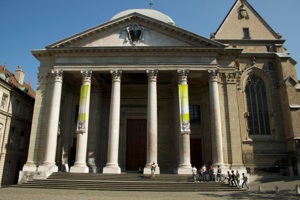
We retraced our steps and entered St Peter’s. I had previously got my bearings wrong and thought that the facade was that of the Palais de Justice. Internally it looks as you would expect of a Roman Catholic building, but with very little adornment, as you would expect in a Reformed building. Let us never forget that many old “protestant” buildings started life as Roman Catholic ones. A cause of complaint by some Roman Catholics that their buildings have been stolen—ignoring that the money came from the people who were made totally unjustified promises about the spiritual good they would receive if only they funded the building work. Who can forget Tetzel’s jingle, concerning purgatory and penances, the money from which funded the building of St Peter’s in Rome: “The moment the coin in the coffer rings, the soul from purgatory springs.” Emotional hogwash—actually, sorry, that’s unfair to hogs. The pulpit Calvin preached from is still there, as is his chair—though I couldn’t work out how he sat in it with that rope tied across it! And you can still see the sweaty marks of the great man on the arms of the chair! (or is it just the superstitious rubbing their hands on it thinking something of Calvin will rub off onto them?) No sign at the bookstall of the DayOne Travel Guide to the life of Calvin (nor yet of George Whitefield—I wonder when that will be ready?). Having typeset the Calvin Travel Guide I was able to print out a personal copy and make use of it—though it lacks pictures and maps and has not been proof-read, but still helpful.
Next door is the Museum of the Reformation. We only had 40 minutes before it closed, so it was only a quick rush round. We’ll return again to give it a proper look. Pleasantly discovered that the Swiss Pass gave us free entry. Found the wooden carving of Calvin in a chair with his finder raised, a photo of which graced the cover of a recent Congregational Concern. As there are signs everywhere saying “no photography” I wonder where the picture came from?
We spent some time reading up on the Huguenots and their problems in the 16th century leading up the the Edict of Nantes. Perhaps when we return again we’ll find information about what happened after the Revocation of the Edict of Nantes. It shows what a dangerous thing religion is in the hands of those who have a totalitarian mentality.
Heading back to the station I was delighted to find that the Jet d’Eau had been turned on again. Feeling weary, and perhaps suffering from sun, heat and dehydration (clear blue sky again today), I didn’t bother trying to find the exact spot, but it looked fine from where I photographed it. And somewhere in the background, probably lost in the mist of the photograph, you could see the Matterblanc—or was it Mont Horn? One or the other.
A little further along we passed a watch shop, with cuckoo clocks in the window. So a quick photograph and Marianne could cross that off the list. Now just got to find a lonely goatherd. If we manage that she’ll doubtless start climbing
every mountain, vaulting
every stream and following
every rainbow, till she finds her dream. Then I kick her and say we’re in Switzerland and not Austria and her name’s not Julie Andrews.
We got back to the station, purchased some food and fluid to keep us going and caught the train back. I’m not used to so much walking, and neither is Marianne. We staggered back from the station and now, after eating she’s collapsed into bed while I type this, and it’s only just 10pm. And I wanted to discuss plans for tomorrow. This Swiss Pass means we can travel to every Swiss city—and more. There’s even a line we can take that cuts through Italy. And a couple where the train goes round in circles as it gains or loses height.

